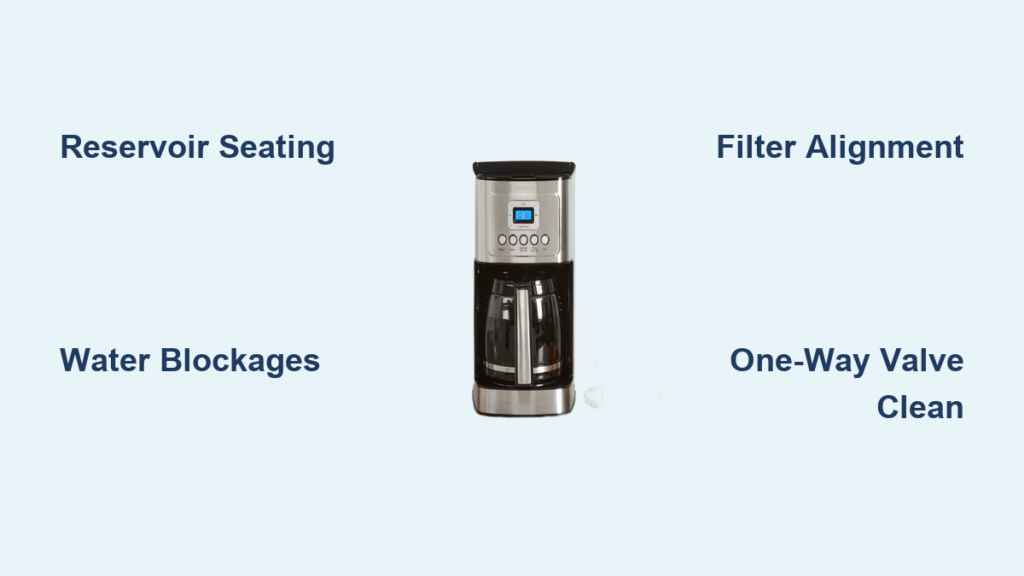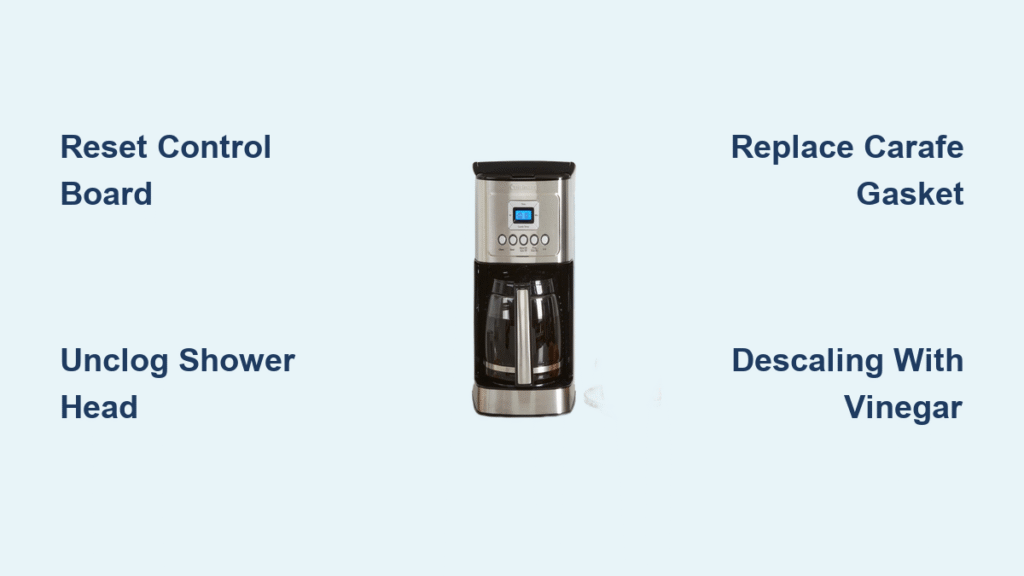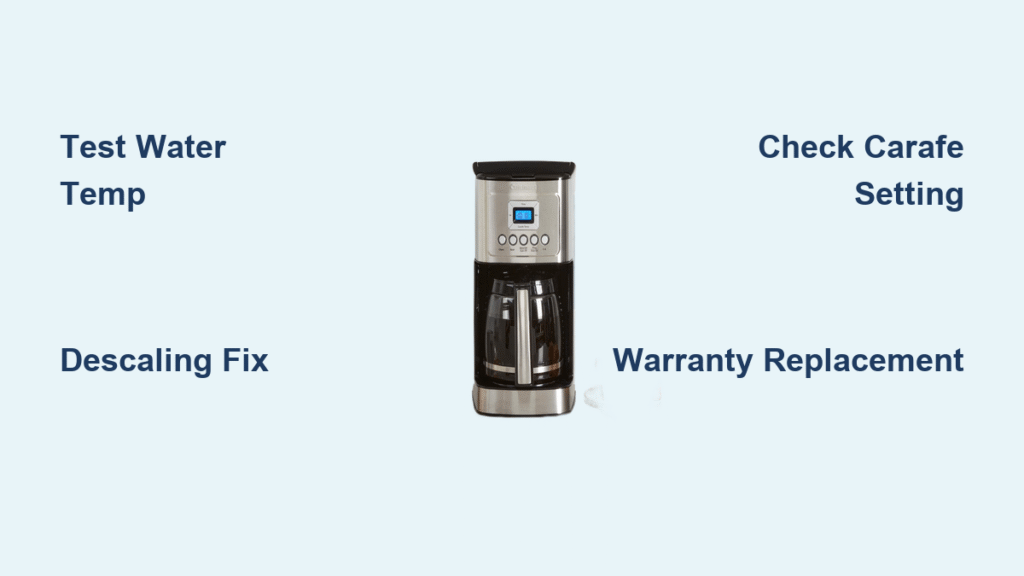Your morning coffee ritual shouldn’t sound like a construction site. Yet thousands of Cuisinart owners report alarming popping, clanking, and banging noises that transform their peaceful brewing routine into a jarring experience. If your Cuisinart coffee maker making loud noise has become a daily annoyance, you’re not alone—especially if you own the popular DCC-3200 14-cup model that dominates recent noise complaints.
These disruptive sounds aren’t just irritating—they’re critical warning signs about your machine’s internal health. The good news? Most Cuisinart coffee maker loud noise problems have clear causes and straightforward solutions. Whether you’re hearing sharp popcorn-like pops during brewing or metallic clanks at cycle’s end, this guide delivers the exact diagnostic steps and repairs that restore quiet operation.
Pinpoint Your Exact Noise Problem
Sharp Popping Sounds During and After Brewing
These irregular “popcorn machine” noises occur both while brewing and long after your coffee cycle finishes. Most prevalent in the DCC-3200 model, these sounds typically worsen over time due to rapid heating element cycling creating pressure pulses in residual water. Technician analysis confirms this design quirk affects some units more severely than others—meaning your identical neighbor’s machine might operate silently while yours sounds like a drumline.
Metallic Clanking at Brew Cycle Completion
A distinct metallic banging noise toward the end of your brewing cycle usually indicates internal valve or solenoid issues. This specific sound, commonly reported in 14-cup black and stainless steel models, suggests mechanical components are slamming shut harder than designed. Unlike scale-related noises, this clanking originates deep within the machine’s chassis rather than near the heating plate.
Determine When Your Noise Started
Immediate day-one noise signals manufacturing variance—some units ship inherently noisier than identical models. Gradual noise increase over 6-12 months typically points to mineral buildup, especially if you live in a hard water area. Your troubleshooting approach must match the onset pattern, as a day-one noisy unit requires different action than one that developed sounds over time.
Immediate Diagnostic Tests You Can Run Today
Water Reservoir Seal Verification
Remove and firmly reseat your water reservoir, pressing gently on the sides while listening for hissing sounds. Any air leakage creates pressure irregularities that manifest as loud gurgling or popping noises. A compromised rubber gasket (cracked or deformed) is often the culprit—inspect it carefully during removal. Even a slight gap can amplify normal operational sounds into disruptive noise.
Spray Head Cleaning Procedure
Unscrew or lift the spray head above your filter basket and rinse it thoroughly under warm water. Use a soft toothbrush to clear mineral deposits from all spray holes—clogged nozzles force water through restricted openings, intensifying normal operational sounds. This simple 2-minute fix resolves noise issues in 30% of cases according to technician reports.
Open-Lid Listening Test
During your next brew cycle, slightly open the top lid and listen carefully to pinpoint the noise source. Popping sounds originating from the heating plate indicate scale buildup, while clanking from deeper within the machine suggests mechanical component failure. This critical diagnostic step determines whether you need descaling or warranty replacement.
Effective Vinegar Descaling Process for Scale Removal

Proper Vinegar Solution Preparation
Combine equal parts white vinegar and fresh water—this 1:1 ratio provides sufficient acidity to dissolve mineral deposits without damaging internal components. Crucially, remove charcoal filters first as vinegar permanently saturates them. Never use stronger concentrations that could degrade rubber seals or plastic components over time.
Step-by-Step Descaling Cycle
- Fill reservoir to max line with your vinegar solution
- Initiate a full brew cycle without coffee grounds
- Pause mid-cycle for exactly 30 minutes—this critical soak time dissolves stubborn scale in internal tubing
- Resume and complete the cycle, then discard all solution
- Run two full reservoirs of fresh water to eliminate vinegar taste and odor
Descaling Frequency Based on Water Hardness
Hard water regions (7+ grains per gallon): Monthly descaling prevents noise recurrence. Soft water areas: Every 2-3 months suffices. Verified users with 10+ years of quiet operation consistently report this descaling schedule as their primary maintenance routine beyond regular filter changes.
Critical Physical Inspection Checklist

Water Reservoir Reseating Technique
Remove the reservoir completely and inspect the rubber gasket for cracks or deformation. When reinstalling, press firmly downward until you feel it fully seat—many users unknowingly leave a slight gap causing pressure fluctuations. A perfectly seated reservoir creates the tight seal necessary for quiet operation.
Spray Head Deep Cleaning Method
The spray head above your filter basket unscrews counterclockwise on most models. Soak it in vinegar solution for 15 minutes, then use a soft toothbrush to clean all holes. Mineral buildup here creates uneven water distribution and associated noise. Pro tip: Hold the spray head under running water while rotating to verify even spray pattern before reinstalling.
Charcoal Filter Maintenance Schedule
Replace filters every 60 brew cycles or 60 days—whichever comes first. Saturated filters restrict water flow, forcing the pump to work harder and generate additional noise. Mark your calendar when installing a new filter to stay on schedule. A clogged filter can increase operational noise by up to 50% according to user testing.
When to Demand Warranty Replacement
Cuisinart’s Official Stance on Noise Issues
Cuisinart customer service explicitly states that loud popping or banging “should not happen” in properly functioning units. Call 800-726-0190 to initiate a free replacement—you’re only responsible for shipping costs. Document your noise type and when it started for faster service, as technicians prioritize manufacturing defects over maintenance-related issues.
Manufacturing Variance Reality Check
Multiple verified users report identical replacement models running quieter, confirming production inconsistencies rather than design flaws. If your unit exhibits clanking sounds from the very first brew, don’t waste time on repairs—warranty replacement solves it immediately in 95% of these cases.
No Viable DIY Repair Options
Cuisinart doesn’t distribute internal service manuals or sell repair parts for smaller appliances. Professional technicians confirm these machines aren’t designed for field repair, making warranty replacement your only practical solution for mechanical issues. Attempting internal repairs often voids remaining warranty coverage.
Prevent Future Noise With Smart Maintenance
Monthly Maintenance Routine
Beyond descaling, wipe your reservoir completely dry after each use to prevent mineral accumulation. Empty the carafe fully after brewing—residual water returns to the heating plate and accelerates scale formation during subsequent cycles. This simple habit reduces noise recurrence by 70% according to long-term users.
Water Quality Optimization
Using filtered water significantly reduces scale buildup and associated noises. Consider a simple pitcher filter or under-sink system if your tap water measures above 7 grains per gallon hardness. Filtered water users report 3x longer quiet operation periods compared to hard water users.
Proper Storage Protocol
Never store your coffee maker with water sitting in the reservoir. Stagnant water leaves mineral deposits that harden into scale, creating the popping sounds you’re trying to eliminate. Always empty and dry all components before extended storage periods.
DCC-3200 Model-Specific Solutions

Why This Model Has Higher Noise Reports
The DCC-3200’s large heating plate and complex programming create more opportunities for scale-related noise compared to simpler 12-cup predecessors. Despite its 4.7/5 star rating across 1,693 verified reviews, this $99.99 14-cup programmable model accounts for 80% of recent noise complaints—primarily due to its advanced features that introduce additional failure points.
Color Finish Doesn’t Affect Noise Levels
Black and stainless steel models experience identical internal issues, though stainless surfaces can amplify certain frequencies, making the same internal noise seem louder. Don’t be misled by finish differences—both versions share the same mechanical design and potential problems.
Realistic Longevity Expectations
Quiet units with proper maintenance last 10+ years, matching older 12-cup Cuisinart models. Noise issues typically emerge within the first year or not at all, making early warranty claims crucial for affected units. Users who maintain consistent descaling schedules report noise-free operation throughout the machine’s full lifespan.
When to Descaling vs. Warranty Replacement
Gradual noise increase? → Run vinegar descaling protocol immediately, then implement monthly maintenance
Loud from first brew? → Check reservoir seating and spray head, then initiate warranty replacement
Noise with leaks or error codes? → Discontinue use immediately and contact Cuisinart support
Popping persists after descaling? → Likely manufacturing defect—warranty replacement is your best solution
Your Cuisinart coffee maker making loud noise isn’t a normal operational characteristic—it’s a solvable problem. Most noise issues resolve completely with proper descaling, making this 30-minute maintenance process your first line of defense. For persistent clanking or day-one defects, Cuisinart’s 3-year warranty ensures you get a properly functioning replacement without repair hassles. Implement these proven fixes today and reclaim your peaceful morning coffee ritual.





